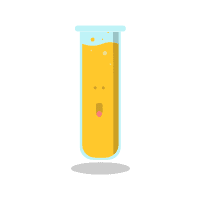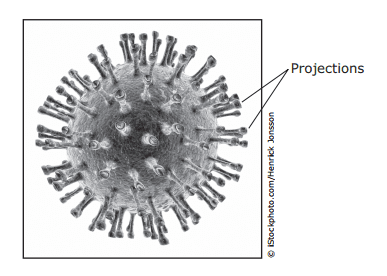
Topic Review: Cells
Quiz by Texas Education Agency
High School
Biology (2017)
Texas Essential Knowledge and Skills (TEKS)
Feel free to use or edit a copy
includes Teacher and Student dashboards
Measures 6 skills from
Measures 6 skills from
With a free account, teachers can
- edit the questions
- save a copy for later
- start a class game
- automatically assign follow-up activities based on students’ scores
- assign as homework
- share a link with colleagues
- print as a bubble sheet
49 questions
Show answers
- Q1A photograph of a virus is shown below. The projections on the surface of this virus allow the virus to -control a host cell's DNAsignal other viruses to infect a host cellmove inside a host cellattach to a host cell60sBIOL.4c
- Q2Which of these statements best explains the process of energy conversion that takes place in the mitochondria?The energy in the bonds of glucose molecules is transferred to the phosphate bonds in ATPEnergy is required for carbon dioxide molecules to form six-carbon sugar moleculesOxygen molecules release energy in the form of heat during combustion reactionsWater molecules and radiant energy are necessary for anaerobic respiration to take place60sBIOL.4b
- Q3A photomicrograph of onion root tip cells during mitosis is shown below. Which phase of mitosis is occurring in the cell indicated by the arrow?MetaphaseTelophaseProphaseAnaphase60sBIOL.5a
- Q4Both euglena and cyanobacteria are photosynthetic unicellular organisms found in pond water. The feature that distinguishes euglena from cyanobacteria is the -presence of ribosomespresence of a nuclear membraneability to maintain homeostasisability to reproduce60sBIOL.4a
- Q5Which cellular process takes place in the ribosomes that are bound to the endoplasmic reticulum?The breakdown of waste materialThe conversion of radiant energy to glucoseThe replication of nucleic acidsThe synthesis of new proteins60sBIOL.4b
- Q6Which of these must occur during S phase of the cell cycle so that two daughter cells can be produced during M phase?The cytoplasm must be separatedThe cell membrane must be expandedThe DNA must be replicatedThe chromosomes must be joined60sBIOL.5a
- Q7The diagram below represents the cell cycle. When cells leave the cell cycle, they exit during G1 phase and then enter G0 phase, a resting period. Most normal cells can leave G0 phase and reenter the cell cycle at G1 phase before entering S phase. Cancer cells are different because they cannot enter G0 phase and are likely to do which of the following?Repeat the cell cycle continuouslyFail to complete S phaseDie after completing mitosisMutate during G1 phase60sBIOL.5b
- Q8Cold sores are caused by the herpes simplex virus type 1. A company that wants to develop antiviral drugs would ask a research immunologist to study -the mechanism used by the virus to infect cellshow closely related the virus is to cold virusesthe metabolism of the virusmeiosis in the virus60sBIOL.4c
- Q9Cell differentiation is critical during embryonic development. The process of cell differentiation results in the production of many types of cells, including germ, somatic, and stem cells. Cell differentiation is most directly regulated by -ATPDNAsugarslipids60sBIOL.5c
- Q10Atherosclerosis is a disease that obstructs blood flow and, therefore, oxygen supply to target organs. A major component of atherosclerosis is the excessive reproduction of smooth muscle cells of the blood vessels. Certain drugs may have the potential to reverse or prevent the unregulated reproduction of the diseased blood-vessel cells. Which of these processes is the most likely target of these drugs?DNA transcriptionCellular respirationErythroblast differentiationCell division60sBIOL.5b
- Q11A person infected with the human immunodeficiency virus (HIV) may not have any symptoms for a period of time. During this period the virus affects the body by doing which of the following?The virus damages immune cells while using their machinery to produce copies of itself.The virus produces toxins that weaken immune cells and prevent them from reproducing.The virus changes the identity of the nucleotides of immune cells to prevent the immune system from functioning normally.The virus uses nutrients meant for immune cells to fuel its own cellular respiration.60sBIOL.4c
- Q12Checkpoints occur between the stages of the cell cycle. If a cell does not meet certain criteria at the end of a stage, it will not move to the next stage. Which of these occurs just before the cell enters the G2 stage of the cell cycle?DNA replicatesThe nucleolus dividesCentrioles formThe nuclear membrane disintegrates60sBIOL.5a
- Q13Which group of organelles is directly responsible for the production of new molecules within a cell?Golgi apparatuses, lysosomes, and the plasma membraneThe nucleolus, vacuoles, and ribosomesRibosomes, the endoplasmic reticulum, and Golgi apparatusesThe endoplasmic reticulum, plastids, and vacuoles60sBIOL.4b
- Q14Severe acute respiratory syndrome (SARS) is an illness caused by a coronavirus. Symptoms including a high fever, headaches, and body aches typically occur two to seven days after infection by the virus. SARS is more serious in elderly patients. This information suggests that the reproductive cycle of the SARS virus is -lysogenic, because the virus is a coronaviruslysogenic, because the virus primarily affects older peoplelytic, because of the quick onset of symptoms after infectionlytic, because the virus causes respiratory illness60sBIOL.4c
- Q15The cellular process known as the sodium-potassium pump was discovered in the 1950s by Jens Christian Skou, a Danish scientist. This process is a form of active transport that moves three sodium ions to the outside of a cell for every two potassium ions that it moves into the cell. Which of these best explains why energy is needed for active transport?Ions are negatively chargedIons are attached to large proteinsIons are moved against the concentration gradientIons are trapped inside the plasma membrane60sBIOL.4b
